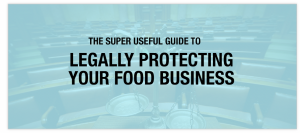
This post should be called “How to avoid spending $3,429 in legal fees”. Why? Because that’s what I just did. I spent my month’s earnings on legal fees. So much for paying rent.
It’s important you hear my story — and take action to protect your intellectual property. (skip the story and go right to learning how to protect your company)
Here’s the story (then I’ll get to how to protect your recipes, company name, etc.):
Back in July, we received a letter from a lawyer who represented a food company (who’s going to remain anonymous because my lawyer said so) asking us to stop using the word “Atomic” on our (now) Ragin’ Rooster mustard — it used to be called “Atomic Rooster”, (RIP).
My initial reaction? Oh, crap.
My second reaction? This is crap. They’ve got nothing on me.
There are a handful of products using “Atomic” in their product name: bbq sauce, hot sauce, restaurants, and even the classic Atomic fireball candy. But, my product was the only mustard.
They wanted me to stop using “Atomic” immediately.
I called my lawyer. Well, he wasn’t my lawyer at the time (you know, had to sign the engagement letter and stuff). But, he was one of the only guys I knew who would have my back – and my company’s interest at heart. Not to mention, he represented one of the best law firms in the state.
Our first meeting cost $367.50.
During that meeting, we reviewed the case and concluded Green Mountain Mustard had a case against the anonymous company. Our lawyer drafter up a letter explaining the relative size of our company, it’s limited distribution, and the fact their trademark wasn’t well protected. Oh, and a list of “not-too-strong” evidence of other companies using the word Atomic. Even though I found smaller companies (including another in Vermont), no national chains or producers were using the term. While evidence, it wasn’t strong.
Regardless, I pushed on.
About a week later, I received another letter from the other company’s lawyer. He wasn’t happy.
The letter stated that we should discontinue use immediately. If we didn’t, the company was prepared to take whatever actions necessary to stop us.
Side note: This company is a multi-million dollar business with distribution across North America. And me? Well, I could barely pay the legal fees to handle this. You get the idea.
I called my lawyer again. He proposed three options:

What would you do?
1. Keep fighting and take it to court
Yes, we could have kept on writing letters back and forth – each letter costing me several hundred dollars. And yes, we could have been sued. But, I wasn’t willing to risk it.
2. Ignore the letter
This would have probably resulted in going to court anyone, and we would have had to pay to get out of the suit. Yeah – apparently you can’t just “put your hands up” for free. I love you, legal system. Love. you.
3. Change the name and be done with this
It was the easiest solution. I had to print new labels anyway. And getting rid of old labels is a secret past time of mine – see the labeling your food product post. I couldn’t pay my lawyers another $3,000. And I couldn’t afford the chance of going to court just to save a flavor that, while popular, wasn’t widely distributed.
I chose the 3rd option. That meant:
- throwing out the 3,000 old labels (a cost of about $240)
- selling off our current inventory (roughly 600 units)
- changing the name
- ordering new labels
Not a big deal. But still a pain. I signed a binding contract with the other company basically agreeing to the above terms. I had to provide a picture of the new product name on the jar, too (oh, and print new business cards and sell sheets…). Part of me wanted to send them all of my old labels. But, I’m better than that :p
Anyway……now to the useful stuff. The information you can use to protect your company from the same thing I experienced last month.
How to build legal assets for your food business
Note: I’m not a lawyer. I never intend to be. And this shouldn’t be taken as legal advice. That’s why I paid my lawyer $245 an hour. This is simply what I learned through the above legal process.

Building your legal assets.
1. Why protect anything at all?
I’ve owned my mustard company for over 4 years. I never put thought into protecting anything, until my lawyer gave me three good reasons to start protecting what I’ve created:
- It’s defensive – protect yourself against any legal threats (like the one I got above)
- It’s offensive – building a legal portfolio is an asset – not a liability – to your company
- Prepare for sale – while I’m not sure this’ll ever happen, you can use your legal assets to increase the sale of your business
2. What can you protect?
While I thought I’d protect everything under the sun, it just doesn’t make sense financially. I don’t have $25,000 laying around. You might, but I’m sure you could think of a million better things to do with the money. But, legal protection should be on the list because there’s a lot to protect:
- Your company name
- Your company logo
- Unique product names
- Slogans and taglines
- Brandmarks
- Characters
- Unique packaging (limited, but possible)
- Made-up words (those are fun, but I don’t have any) ex: apple for electronics.
Now, you obviously don’t have to protect everything. I mean, money doesn’t grow on trees. That’s why there’s this next question.
3. What should you protect first?
I was advised to protect my company name first. Seeing as it’s plastered all over everything – labels, cards, banners, etc. I’d never want anyone else to use Green Mountain Mustard (rumor has it in the 1980’s there used to be another Green Mountain Mustard, but they never protected the name). Next, my legal team would look at protecting each flavor name.
Side note again: I have “cute” names for all of my products – my customers love them – but they’re unique to my company. Things like “horseradish mustard” and “black currant vinaigrette” are common place and can’t be protected.
I was advised not to protect my logo – the visual part. It’s not like the apple “apple” or the nike “swoosh”. It’s 6 lines that form a mountain. Nothing terribly unique to warrant protection from impostors.
4. Do you really need to protect your logo?
Yes – if you have a distinguishable brand-mark, like I mentioned above in question 3. If it’s just text and a couple lines – or clip art you found online – don’t bother. It’s a waste of money. But, if another company’s logo looks suspiciously like yours, you may want think about protection.
5. How do you go about protecting anything?
The United States Patent & Trademark Office (USPTO) is your friend. There, you’re able to search for any trademark, copyright, or protection a company or individual has ever filed for. If you’re a data nerd like me, it’s pretty cool. So, before you trademark “Jumpin’ Jack’s Crazy Jalapeno Sauce” someone might already have protected it (Blast!). Search here first before you invest any money.
You can do this yourself. However, to make sure it’s done correctly, I’d advise partnering with a trusted law firm that specializes in intellectual property law. The process is rather simple to file copyrights and trademarks – just a couple pages – but there’s a reason people go to law school – to do it right.
You’ll get a piece of paper in the mail asking for the filing fee (it honestly looks like junk mail) to be paid within a few weeks. Speaking of filing fees…..
6. What does it cost to protect everything?
To file a trademark or copyright will cost you $375/trademark. In addition to the fee, my lawyer charged me $800 to take care of everything. Again, you can do this yourself, and just pay the $375. This only protects you in the United States. Country specific – or even global filing – is much more expensive and only makes sense if you’re exporting products to other countries. Or, if you’re just an enormous multi-national corporation.
What I protected with Green Mountain Mustard
I chose to protect my company name – not the logo. Just the word mark. That means, no matter how anyone styles Green Mountain Mustard – colors, fonts, size, etc – I can take legal action. While I believe it will never happen, it’s nice to start building my legal portfolio.
When I get a little bit more cash into the company, I’ll protect my flavor names. At $325 a piece (if I do the work myself), it gets pricey quick. Guess that means I’ve got to stop making new flavors, huh?
Of course this is not legal advice. I’m only sharing my experiences. While I’d love to answer your questions, I’d recommended talking to your lawyer first. They’re a lot smarter than me :)

Leave A Comment